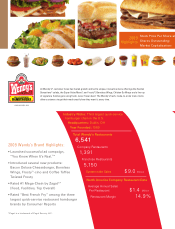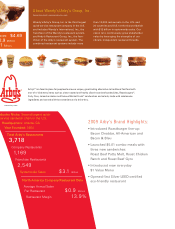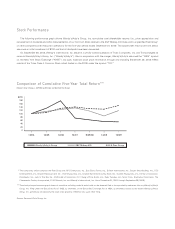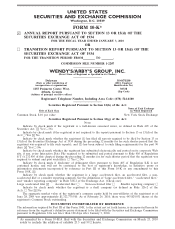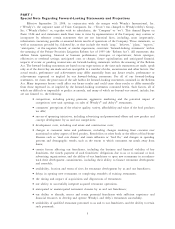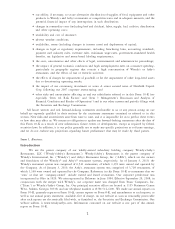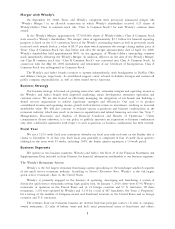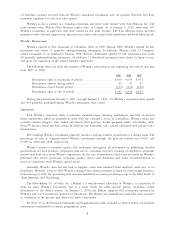Wendy's 2009 Annual Report Download - page 13
Download and view the complete annual report
Please find page 13 of the 2009 Wendy's annual report below. You can navigate through the pages in the report by either clicking on the pages listed below, or by using the keyword search tool below to find specific information within the annual report.competes with other restaurant companies and food outlets, primarily through the quality, variety,
convenience, price and value perception of food products offered. The number and location of units, quality and
speed of service, attractiveness of facilities, effectiveness of marketing and new product development by
Wendy’s and its competitors are also important factors. The price charged for each menu item may vary from
market to market (and within markets) depending on competitive pricing and the local cost structure. Wendy’s
also competes within the food service industry and the quick service restaurant sector not only for customers,
but also for personnel, suitable real estate sites and qualified franchisees.
Wendy’s competitive position is differentiated by a focus on quality, its use of fresh, never frozen ground
beef in the United States and Canada and certain other countries, its unique and diverse menu, its promotional
products, its choice of condiments and the atmosphere and decor of its restaurants.
Many of the leading restaurant chains have focused on new unit development as one strategy to increase
market share through increased consumer awareness and convenience. This has led to increased competition for
available development sites and higher development costs for those sites, although the recent decline in
commercial real estate values has somewhat offset those costs. Competitors also employ marketing strategies
such as frequent use of price discounting, frequent promotions and heavy advertising expenditures. Continued
price discounting in the quick service restaurant industry and the emphasis on value menus has had and could
continue to have an adverse impact on Wendy’s. In addition, the growth of fast casual chains and other in-line
competitors could cause some fast food customers to “trade up” to a more traditional dining out experience
while keeping the benefits of quick service dining.
Other restaurant chains have also competed by offering high quality sandwiches made with fresh
ingredients and artisan breads. Several chains have also sought to compete by targeting certain consumer
groups, such as capitalizing on trends toward certain types of diets (e.g., low carbohydrate or low trans fat) by
offering menu items that are promoted as being consistent with such diets.
Additional competitive pressures for prepared food purchases come from operators outside the restaurant
industry. A number of major grocery chains offer fresh deli sandwiches and fully prepared food and meals to go
as part of their deli sections. Some of these chains also have in-store cafes with service counters and tables
where consumers can order and consume a full menu of items prepared especially for that portion of the
operation. Additionally, convenience stores and retail outlets at gas stations frequently offer sandwiches and
other foods.
Quality Assurance
Wendy’s Quality Assurance program is designed to verify that the food products supplied to our
restaurants are processed in a safe, sanitary environment and in compliance with our food safety and quality
standards. Wendy’s Quality Assurance personnel conduct multiple on-site sanitation and production audits
throughout the year at all of our core menu product processing facilities, which includes beef, poultry, pork,
buns, french fries, Frostydessert ingredients, and produce. Animal welfare audits are also conducted every
year at all beef, poultry, and pork facilities to confirm compliance to our required animal welfare and handling
policies and procedures. In addition to our facility audit program, weekly samples of beef, poultry, and other
core menu products from our distribution centers are randomly sampled and analyzed by a third party
laboratory to test conformance to our quality specifications. Each year, Wendy’s representatives conduct
unannounced inspections of all company and franchise restaurants to test conformance to our sanitation, food
safety, and operational requirements. Wendy’s has the right to terminate franchise agreements if franchisees fail
to comply with quality standards.
Acquisitions and Dispositions of Wendy’s Restaurants
Wendy’s has from time to time acquired the interests of and sold Wendy’s restaurants to franchisees, and
it is anticipated that the company may have opportunities for such transactions in the future. Wendy’s
generally retains a right of first refusal in connection with any proposed sale of a franchisee’s interest. Wendy’s
will continue to sell and acquire restaurants in the future where prudent.
International Operations
As of January 3, 2010, Wendy’s had 136 company owned and 235 franchised restaurants in Canada and
293 franchised restaurants in 20 other countries and U.S. territories. Wendy’s is evaluating further expansion
into other international markets. Wendy’s has granted development rights in the certain countries and U. S.
6


